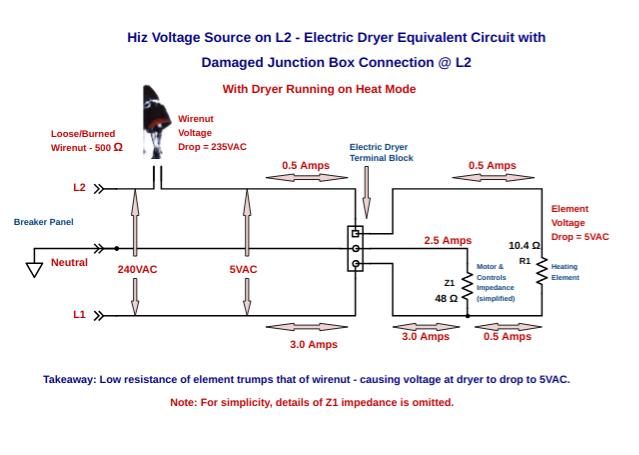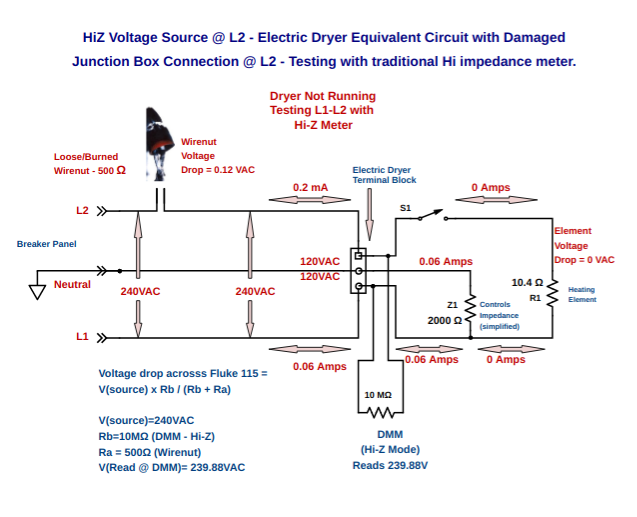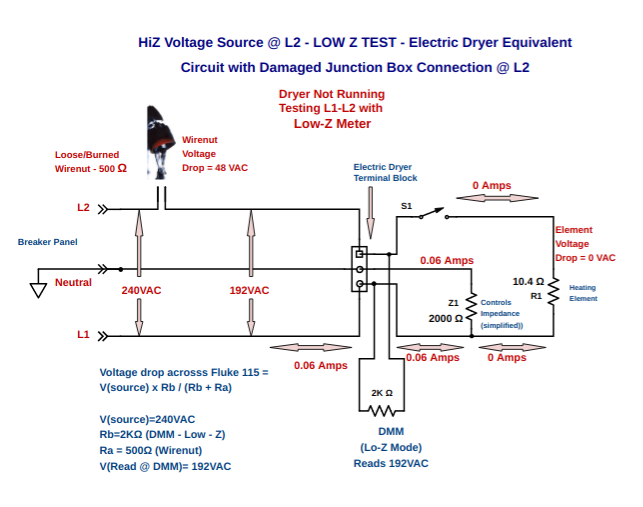Loss of a 240v Voltage Leg of an Electric Dryer
What happens when a loose connection at the junction box or terminal block on an electric dryer causes one of your line voltages to drop out? Here are the equivalent circuits and how to test for this loss.
Figure 1 is a simplified equivalent circuit of an electric dryer that is running normally. Note that:
1) The heating element has a 10.4 ohm resistance and draws 23 amps by itself.
2) The motor and control circuit has an “impedance” of 48 ohms as determined by current draw – and draws 2.5 amps.
3. Current through L2 is 23 amps.
4. Current through L1 is 25.5 amps.

Figure 2 shows what happens when the dryer is running on heat mode and L2 drops out due to a loose connection at either the junction box, receptacle, or terminal block. Note that:
1) The heating element now only has 5 volts across it. Why? The 500 ohm loose connection at the junction box on L2 and the heating element form a voltage divider network. This results in a voltage drop of 235 volts across the junction of the 2 loose L2 wires – leaving the rest (5 volts) for the heating element.
2) Here is the simple formula: VR1 = V( R1 / R1 + R2 ) = 240 ( 500 / 510.4 ) = 240 ( 0.98 ) = 235v .
3) The motor circuit and current is unaffected because that is between L1 and Neutral.

Next in Figure 3, consider the same dryer that is not running. How does this affect the voltage readings – if you use a typical meter? With no load on the circuit. There is no longer a significant voltage divider. Here’s what happens:
1) When you put your high impedance meter across L1 and L2, you put an insignificant load on the circuit.
2) Since the loose connection is 500 ohms and your meter has about a 10 M ohm impedance, you will measure approximately 240 volts and may think all is well.
3) All is not well though. Since there is no load on the circuit, the loose connection will not reveal itself.

Let’s now consider the same scenario while measured with a low Z meter. In Figure 4, note:
1) Low impedance of meter puts a load on the circuit.
2) Equivalent resistance of meter is say – 2k ohms.
3) Voltage divider as calculated in the diagram shows 192 volts as measured by the meter. This is much lower than the expected 240 volt reading.
4) This test reveals a voltage deficiency without having to turn the dryer on to put a load on the circuit – and highlights how useful a LowZ meter can be.

Don’t forget:
“Diverting 10 min/day of social media time towards learning something new, is 5 hours of newfound monthly knowledge.” – SM
To DONATE to the Tech Circuit – CLICK HERE
Alphabetical Links to all Tech Circuit Articles and Blogs – CLICK HERE
Links to all Tech Circuit Cheat Sheets/Field References for Appliance/HVAC Techs – CLICK HERE
For additional electrical and electronics learning material for field techs, visit our homepage at http://www.TechCircuit.org or our Facebook group at https://www.facebook.com/groups/746823709133603.
We are a participant in the Amazon Services LLC Associates Program, an affiliate advertising program designed to provide a means for us to earn fees by linking to Amazon.com and affiliated sites.

I want to become a member.